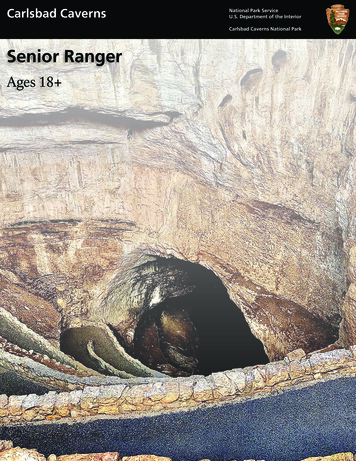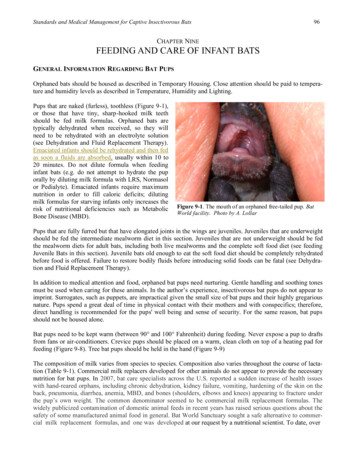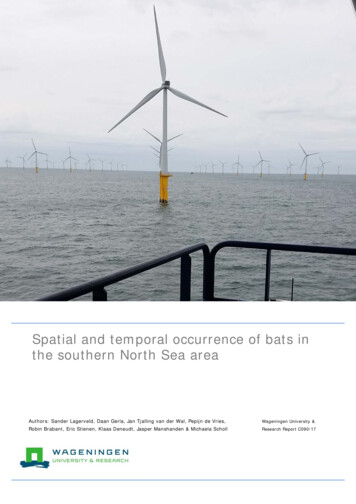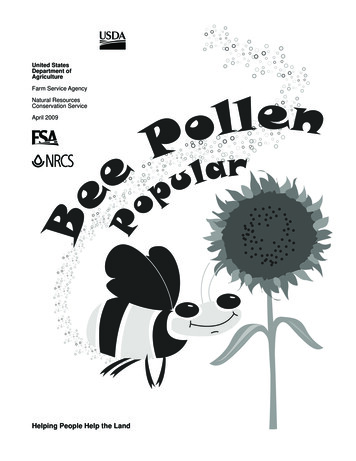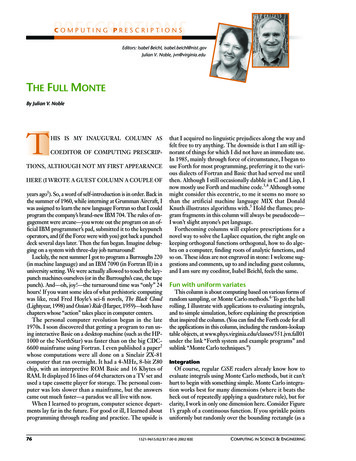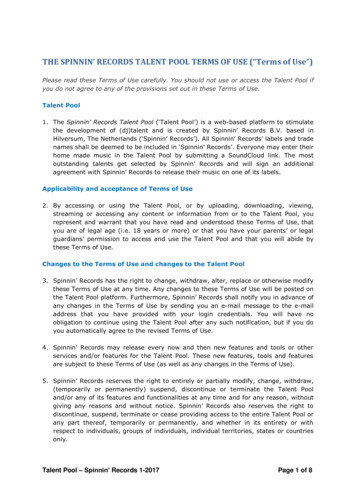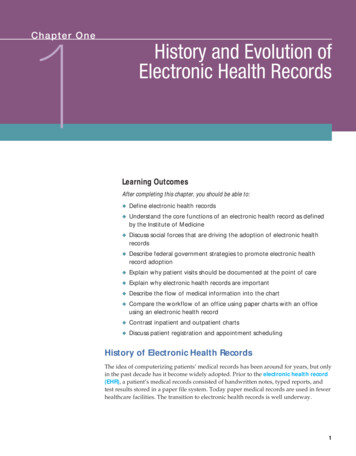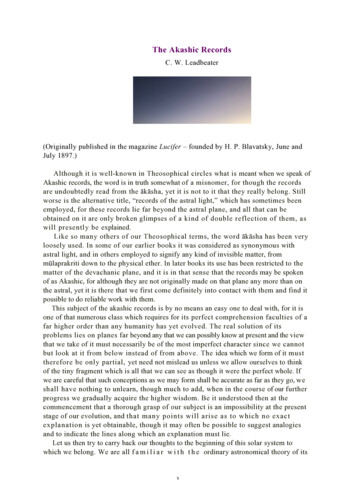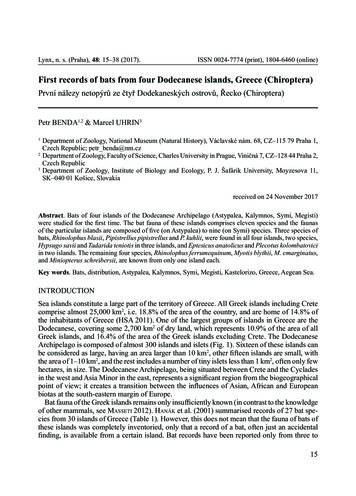
Transcription
Lynx, n. s. (Praha), 48: 15–38 (2017).ISSN 0024-7774 (print), 1804-6460 (online)First records of bats from four Dodecanese islands, Greece (Chiroptera)První nálezy netopýrů ze čtyř Dodekaneských ostrovů, Řecko (Chiroptera)Petr BENDA1,2 & Marcel UHRIN3123Department of Zoology, National Museum (Natural History), Václavské nám. 68, CZ–115 79 Praha 1,Czech Republic; petr benda@nm.czDepartment of Zoology, Faculty of Science, Charles University in Prague, Viničná 7, CZ–128 44 Praha 2,Czech RepublicDepartment of Zoology, Institute of Biology and Ecology, P. J. Šafárik University, Moyzesova 11,SK–040 01 Košice, Slovakiareceived on 24 November 2017Abstract. Bats of four islands of the Dodecanese Archipelago (Astypalea, Kalymnos, Symi, Megisti)were studied for the first time. The bat fauna of these islands comprises eleven species and the faunasof the particular islands are composed of five (on Astypalea) to nine (on Symi) species. Three species ofbats, Rhinolophus blasii, Pipistrellus pipistrellus and P. kuhlii, were found in all four islands, two species,Hypsugo savii and Tadarida teniotis in three islands, and Eptesicus anatolicus and Plecotus kolombatoviciin two islands. The remaining four species, Rhinolophus ferrumequinum, Myotis blythii, M. emarginatus,and Miniopterus schreibersii, are known from only one island each.Key words. Bats, distribution, Astypalea, Kalymnos, Symi, Megisti, Kastelorizo, Greece, Aegean Sea.INTRODUCTIONSea islands constitute a large part of the territory of Greece. All Greek islands including Cretecomprise almost 25,000 km2, i.e. 18.8% of the area of the country, and are home of 14.8% ofthe inhabitants of Greece (HSA 2011). One of the largest groups of islands in Greece are theDodecanese, covering some 2,700 km2 of dry land, which represents 10.9% of the area of allGreek islands, and 16.4% of the area of the Greek islands excluding Crete. The DodecaneseArchipelago is composed of almost 300 islands and islets (Fig. 1). Sixteen of these islands canbe considered as large, having an area larger than 10 km2, other fifteen islands are small, withthe area of 1–10 km2, and the rest includes a number of tiny islets less than 1 km2, often only fewhectares, in size. The Dodecanese Archipelago, being situated between Crete and the Cycladesin the west and Asia Minor in the east, represents a significant region from the biogeographicalpoint of view; it creates a transition between the influences of Asian, African and Europeanbiotas at the south-eastern margin of Europe.Bat fauna of the Greek islands remains only insufficiently known (in contrast to the knowledgeof other mammals, see Masseti 2012). Hanák et al. (2001) summarised records of 27 bat species from 30 islands of Greece (Table 1). However, this does not mean that the fauna of bats ofthese islands was completely inventoried, only that a record of a bat, often just an accidentalfinding, is available from a certain island. Bat records have been reported only from three to15
four islands of the Dodecanese, namely from Rhodes, Karpathos, Kos, and possibly also fromLeros. Interestingly, most of the species remain known only from a single record from theparticular island of this Archipelago.The oldest records of bats from the Dodecanese come from Rhodes, from the times of theItalian occupation of the Archipelago; Festa (1914) and De Beaux (1929) collected specimensof three bat species from this island, Rhinolophus ferrumequinum, R. blasii and Pipistrelluspipistrellus. Pieper (1965, 1966) discovered additional four bat species in Rhodes, Miniopterusschreibersii, Rhinolophus hipposideros, Pipistrellus kuhlii, and Tadarida teniotis, however,the latter three species only from owl pellets. Volleth (1987) reported a record of Hypsugosavii from Rhodes and von Helversen (1998) several records of Eptesicus anatolicus fromthis island. Until now, Rhodes represents the only part of any European country, where thelatter bat species has been documented. Spitzenberger et al. (2006) reported a specimen ofPlecotus kolombatovici from Rhodes (originally mentioned as P. austriacus by von Helversenin Mitchell-Jones et al. 1999 and by Spitzenberger et al. 2001). Finally, Kafkaletou-Diez etal. (2015) found Myotis myotis in Rhodes.Two other species of bats, Pipistrellus pygmaeus and Nyctalus leisleri, were reported byHanák et al. (2001) to occur in Rhodes, based on single records of echolocation calls obtainedby a heterodyne bat detector. We suggest the occurrence of these bats should be confirmed byfindings of individuals or at least recordings of their calls identifiable by an acoustic softwareanalysis (similarly as it was confirmed for Pipistrellus pipistrellus from Rhodes by Mayer& von Helversen 2001).Smaller numbers of bat species than from Rhodes are known from two other large Dodecaneseislands, Karpathos and Kos (Tables 1, 2, 4), although from Karpathos the oldest record comesfrom the 1930s, similarly to the situation in Rhodes. Von Wettstein (1942) first mentionedMyotis blythii from Karpathos, other records of this species from the island were later reported also by Pieper (1965) and Mertens (1967). The occurrence of Pipistrellus pipistrellus inKarpathos was mentioned by Kanelli & Hadzisarantou (1963) and Rhinolophus blasii andTeniotis teniotis by Pieper (1965). Finally, Pieper (1977) reported two additional bat speciesfrom this island, Myotis emarginatus and Hypsugo savii, the latter species was found there alsoby von Helversen (1989).Only three papers deal with the bats of Kos, all issued in the 1960s and 1970s; Pieper (1966)briefly reported records of Tadarida teniotis and Myotis myotis from this island, and Martens(1967) of Rhinolophus ferrumequinum and Miniopterus schreibersii. Additionally, Iliopoulou-Georgoudaki (1977) reported a finding of a maternity colony of Pipistrellus pipistrellus fromthis island.However, in the atlas of the geographical distribution of mammals in Europe edited byMitchell-Jones et al. (1999), several points, representing occurrence of certain species in the50 50 km squares, appeared in the areas of the Dodecanese, where no records are available (forthe Greek territory, these distribution reviews of bats were prepared by O. von Helversen, seeMitchell-Jones et al. 1999: 14). In some cases, these records are acceptable without question,such as the occurrence of Miniopterus schreibersii in Karpathos and Rhinolophus hipposideros in Kos. On the other hand, there is also a point suggesting an occurrence of Rhinolophuseuryale in Rhodes, which could be theoretically acceptable, but as in the only southern islandof Greece; this species is not known from Crete (see Benda et al. 2009) and was found onlyin Lesbos, Petala and Cephalonia among the eastern Mediterranean islands (see Hanák et al.2001). Moreover, a confusion with very similar Rhinolophus blasii, which is known from16
many Greek islands, including Crete and the Dodecanese, cannot be excluded (Table 4; seealso Hanák et al. 2001, Benda et al. 2009). Thus, this report needs a confirmation in a revisedidentification of a specimen.A bit different case in the atlas by Mitchell-Jones et al. (1999) is the occurrence spot suggestinga record of Tadarida teniotis at an approximate position of the island of Leros (but some otherislands in its vicinity can be also considered, e.g. Patmos or Lipsi); so, it is not clear whether itis the accurate geographical affiliation of the respective point, or whether the unusual positionof the point in fact represents a misprint (this is a case of e.g. the map of the distribution ofRhinolophus ferrumequinum, where two points are placed in the sea, see Mitchell-Jones etal. 1999: 95).In summary, from the Dodecanese Archipelago comprising thirty islands larger than one squarekilometre, 13–16 bat species are known to occur only in 3–4 islands (Table 2). The most diversefauna was reported from Rhodes, with 11–14 species, followed by Karpathos with 6–7 speciesand Kos with 5–6 species; one species is possibly known from Leros. With only six exceptions,Fig. 1. The Dodecanese Archipelago; blue – islands where literature records of bats were available (Table 2);red – islands where bats were documented for the first time.Obr. 1. Dodekaneské souostroví; modře – ostrovy, na nichž byli z literatury netopýři již známi (tab. 2);červeně – ostrovy, na nichž byli netopýři zjištěni poprvé.17
,26019,793257413,44711[ 1]–11–2–11114Cyclades2Sterea Ellada15481–CreteAR island / ostrov GNKafkaletou-Diez et al. 2015Hanák et al. 2001, [von Helversen 1999]–Hanák et al. 2001Lataste 1885–Wettstein-Westersheim 1933, Cheke & Ashcroft 2017–Kanneli & Hadzisarantou 1963Hanák et al. 2001Miller 1912Kanneli & Hadzisarantou 1963Douglass 1892, Hanák et al. 2001Lindermayer 1855, Kafkaletou-Diez et al. 2015Benda et al. 2009–Kahmann 1959Kahmann 1959reference / zdrojTable 1. Review of geographical features of the Greek islands (after HSA 2011) and numbers of their known bat species (all 89 islands largerthan 9 km2 are included plus two smaller islands from which bat records are also available). Legend: AR area ranking; GN Greek name; RO area; CL coastline length; MA maximum altitude; PO population; BS known number of bat species; [] species known only fromuncertain and/or doubtful records; von Helversen 1999 von Helversen (in Mitchell-Jones et al. 1999)Tab. 1. Přehled geografických charakteristik řeckých ostrovů (podle HSA 2011) a známé počty jejich druhů netopýrů (zahrnuto je všech 89 ostrovů větších než 9 km2 a dva menší ostrovy z nichž jsou také k disposici nálezy netopýrů). Legenda: AR pořadí ostrova podle velikosti; GN řecké jméno; RO rozloha; CL délka pobřeží; MA největší nadmořská výška; PO počet obyvatel; BS počet známých druhů netopýrů;[] druhy známé pouze z neurčitých či pochybných nálezů; von Helversen 1999 von Helversen (in Mitchell-Jones et al. 1999)
��–––BS–––Kanneli & Hadzisarantou 1963––––––––––reference / zdroj4 RhodesΡόδος1,401.52511,216 115,334 11[ 3]Hanák et al. 2001, Spitzenberger et al. 2006, KafkaletouDiez et al. 2015, [von Helversen 1999]15 KarpathosΚάρπαθος300.21751,2156,5436[ 1]Hanák et al. 2001, [von Helversen 1999]16 KosΚως287.612284330,8285[ 1]Hanák et al. 2001, [von Helversen 1999]26 KalymnosΚάλυμνος110.610367616,3686this review29 AstypaleaΑστυπάλαια96.41274821,3855this review39 KassosΚάσος66.4286011,013––41 TilosΤήλος61.576612521––42 SymiΣύμη57.9876172,5949this review43 LerosΛέρος54.1833278,123[1][von Helversen 1999]48 NissyrosΝίσυρος41.330698915––53 PatmosΠάτμος34.1712692,997––57 ChalkiΧάλκη27.044593295––Dodecanese rakleaPolyegosGyarosKerosRiniaDonoussaThirassiaAR island / ostrov GNTable 1. (continued)Tab. 1. (pokračování)
�–––this reviewreference / zdroj3 LesbosΛέσβος1,636.041596890,43611Hanák et al. 20015 ChiosΧίος842.82291,29751,7734[ 1]Kock 1974a, Kafkaletou-Diez et al. 2015, [von Helversen 1999]North Aegean Islands6 nák et al. 2001, Gaisler 2006, Kafkaletou-Diez et al.20157 CorfuΚέρκυρα585.3251906 107,51410Niethammer 1962, Hanák et al. 200110 lou-Geordoudaki 197714 LefkadaΛευκάδα301.11391,15820,2951[ 1]von Wettstein 1942, [von Helversen 1999]17 KythiraΚύθηρα277.71225073,5323Kanneli & Hadzisarantou 1963, Martens 1967, Niethammer 197130 IthakaΙθάκη95.81048093,210––58 KalamosΚάλαμος25.132754510––60 PaxiΠαξοί24.6372482,405––64 MeganissiΜεγανήσιον20.152309992––65 AntikythiraΑντικύθηρα19.83137839––69 0 SchizaΣχίζα12.12320117––84 OthoniΟθωνοί10.417393340––89 SapienzaΣαπιέντζα9.0222197––– PetalasΠεταλάς5.5–25103Lanza 1957Ionian 88SariaLipsiPserimosAgathonissiLevithaMegistiROAR island / ostrov GNTable 1. (continued)Tab. 1. (pokračování)
21SamosLemnosIkariaAg. �μνοςΙκαρίαΆ. hosKyra ΑλόννησοςΣκίαθοςΚυρά �12 Thassos22 6591,2041,61113,4472,71295Thracian Islands32364461637882Saronic Islands19314045597483North Sporades89184649567585AR island / ostrov GNTable 1. (continued)Tab. 1. (pokračování)Hanák et al. 2001, Lane & Alivizatos 2006Crucitti 1987, Hanák et al. 2001–––––––Pohle 1953, Georgiakakis et al. 2012––Hanák et al. 2001–––Hanák et al. 2001, Kafkaletou-Diez et al. 2015–Kanneli & Hadzisarantou 1963, van Laar & Daan 1964–––––reference / zdroj
all published records of particular bat species from the particular island represent single findings.Thus, despite the wide popularity of the Dodecanese islands as a destination for travellers, thebiota of this Archipelago (or at least its parts) still remains rather understudied.Here we bring the first data on bat occurrence from four other Dodecanese islands, viz. Astypalea, Kalymnos, Symi, and Megisti (Kastelorizo). Although these islands belong to smallto medium-sized among the islands of the Archipelago (Table 1), eleven bat species weredocumented from them.MATERIAL AND METHODSWe visited four islands of the Dodecanese Archipelago, viz. Astypalea, Kalymnos, Symi, and Megisti(Kastelorizo), for a standardised week long period during the summer-autumn transition (late August toearly October); see Tables 1 and 2 for description data on the respective islands. Data on bats were collected by standard methods (direct observation, netting, detection of echolocation calls) from 26 localities,see Appendix and Figs. 2–9. The lists of records (arranged in alphabetical and/or chronological orders)include, for each item, the following information: name of the locality (each record is primarily listed bya name of the nearest settlement or notable physical feature), and/or description of the record site, date,type of record (det. detected, exam. examined, obs. observed, rec. recorded), and a number ofrecorded bats with indication of their sex and age (ad adult, sad subadult); the numbers in bracketstyped in bold and italics [X] denote the number of recorded call sequences.Acoustic recordings were made using a portable ultrasound detector D-240x (Pettersson ElektronikAB, Uppsala, Sweden) set on the time-expansion mode and connected to the Edirol R-09HR recorder(Roland Corp., Japan). The analysed bat calls were recorded in free flight under natural conditions. Therecordings were analysed with the BatSound Pro 4.1.4 software (Pettersson Elektronik AB, Uppsala,Sweden). Time-expanded sequences (expansion factor 10) were digitised at the sampling rate of 48 kHzwith 16-bit precision and saved as *wav files. A 1024 pt. FFT with Hanning window was used for theanalyses; oscillograms, power spectra and spectrograms were evaluated. For each echolocation call, thefollowing parameters were measured: pulse duration (PDUR), start frequency (SF), end frequency (EF, bothSF and EF at –30 dB below the peak power spectral intensity), frequency of maximum energy (FMAXE)and inter-pulse interval (IPI, the time between two consecutive calls).In most cases, we used only high quality recordings for the analyses. Only the search phase calls weremeasured. In total, we analysed 72 call sequences (373 calls) of seven bat species (Table 3). The speciesidentification was made in accordance to the data by Papadatou et al. (2008) and Benda et al. (2010,2012); in some cases, the recording was found useless for the call analysis and was used just for thespecies identification.RECORDSAstypaleaRhinolophus blasii Peters, 1866Agios Konstantinos, gardens, 28 September 2017: det. & rec. calls of at least 1 foraging ind. [1]; – Livadia, Fragma, northern bank, 26 September 2017: det. & rec. calls of 1 foraging ind. [1]; – Vatses, Negroucaves, lower cave, 28 September 2017: obs. 5 inds., det. & rec. calls of 1–2 inds. [2].Hypsugo savii (Bonaparte, 1837)Agios Konstantinos, gardens, 28 September 2017: det. & rec. calls of several foraging inds. [2]; – FteraMt., Stavros, at a spring, 29 September 2017: det. & rec. calls of several passing inds. [2]; – Livadia,village, 24 September 2017: det. & rec. calls of several foraging inds. [3]; – Livadia, Fragma, northernbank, 26 September 2017: det. & rec. calls of several foraging inds. [4]; – Hora, castle, 25 September2017: net. 1 ad, det. & rec. calls of several foraging inds. [4].22
Table 2. List of bat species known from the Dodecanese islands. For legend see Table 1.Tab. 2. Přehled druhů netopýrů známých z Dodekaneských ostrovů. Legenda viz tab. 1.Species acronyms / zkratky jmen druhů: Rfer Rhinolophus ferrumequinum; Rhip Rhinolophus hipposideros; Reur Rhinolophus euryale; Rbla Rhinolophus blasii; Mmyo Myotis myotis; Mbly Myotisblythii; Mema Myotis emarginatus; Eana Eptesicus anatolicus; Hsav Hypsugo savii; Ppip Pipistrellus pipistrellus; Ppyg Pipistrellus pygmaeus; Pkuh Pipistrellus kuhlii; Nlei Nyctalus leisleri;Pkol Plecotus kolombatovici; Msch Miniopterus schreibersii; Tten Tadarida teniotisAR isl. / ost.BS bat species / druhy netopýrůoriginal reference / původní zdroj1 Rhodes 11–14 Rfer, Rhip, [Reur], Rbla, Mmyo,Festa 1914, De Beaux 1929, Pieper 1965,Eana, Hsav, Ppip, [Ppyg], Pkuh,1966, Volleth 1987, von Helversen 1989,[Nlei], Pkol, Msch, Tten1998, 1999, Hanák et al. 2001, Mayer & vonHelversen 2001, Spitzenberger et al. 2001,2006, Kafkaletou-Diez et al. 20152 Karpathos 6–7 Rbla, Mbly, Mema, Hsav, Ppip,von Wettstein 1942, Kanelli & Hadzisa [Msch], Ttenrantou 1963, Pieper 1965, 1977, Martens1967, von Helversen 1989, 19993 Kos5–6 Rfer, [Rhip], Mmyo, Ppip, Msch,Pieper 1966, 1977, Martens 1967, Iliopou Ttenlou-Georgudaki 1977, von Helversen 19994 Kalymnos6 Rbla, Hsav, Ppip, Pkuh, Pkol, Tten this review5 Astypalea5 Rbla, Hsav, Ppip, Pkuh, Ttenthis review8 Symi9 Rbla, Mbly, Mema, Eana, Hsav,this reviewPpip, Pkuh, Pkol, Msch9 Leros[1] [Tten]von Helversen 199918 Megisti6 Rfer, Rbla, Eana, Ppip, Pkuh, Tten this reviewPipistrellus pipistrellus (Schreber, 1774)Livadia, Fragma, northern bank, 26 September 2017: det. & rec. calls of at least 1 foraging ind. [1].Pipistrellus kuhlii (Kuhl, 1817)Ftera Mt., Stavros, at a spring, 29 September 2017: det. & rec. calls of 1 passing ind. [1]; – Livadia,village, 24 September 2017: det. & rec. calls of at least 1 foraging ind. [1]; – Livadia, Fragma, northernbank, 26 September 2017: det. & rec. calls of numerous foraging inds. [11]; – Hora, castle, 25 September2017: det. & rec. calls of several foraging inds. [3].Tadarida teniotis (Rafinesque, 1814)Agios Konstantinos, gardens, 28 September 2017: det. & rec. calls of at least 1 passing ind. [3]; – FteraMt., Stavros, at a spring, 29 September 2017: det. & rec. calls of several passing inds. [4]; – Hora, castle,25 September 2017: det. & rec. calls of at least 1 foraging ind. [1], 30 September 2017: det. & rec. callsof at least 1 passing ind. [1]; – Livadia, village, 24 September 2017: det. & rec. calls of 1 passing ind. [1];– Livadia, Fragma, northern bank, 26 September 2017: det. & rec. calls of several foraging inds. [2].KalymnosRhinolophus blasii Peters, 1866Skalia, Skalia cave, 3 October 2017: obs. 3 inds. inside the cave, net. 1 ad at the cave entrance.23
Hypsugo savii (Bonaparte, 1837)Rina, corniche, 6 October 2017: det. & rec. calls of at least 1 foraging ind. [1].Pipistrellus pipistrellus (Schreber, 1774)Arginonta, corniche, 6 October 2017: det. & rec. calls of several foraging inds. [5]; – Kantouni, village,1 October 2017: det. & rec. calls of numerous foraging inds. [25]; – Pothia, at the Epta Parthenon cave,2 October 2017: det. & rec. calls of numerous foraging inds. [5]; – Rina, corniche, 6 October 2017: det.& rec. calls of numerous foraging inds. [11].Pipistrellus kuhlii (Kuhl, 1817)Kantouni, village, 1 October 2017: det. & rec. calls of several foraging inds. [2]; – Pothia, at the AgiaVarvara cave, 5 October 2017: det. & rec. calls of 1 foraging ind. [1]; – Pothia, at the Epta Parthenoncave, 2 October 2017: det. & rec. calls of several foraging inds. [1]; – Rina, corniche, 6 October 2017:det. & rec. calls of several foraging inds. [4]; – Skalia, at the Skalia cave, 3 October 2017: det. & rec.calls of 1 foraging ind. [1].Fig. 2. Map of Astypalea with localities of bat occurrence; although the bat research was carried out inthe whole island, bats were documented only in the south-western part of Astypalea, Exo Nisi; pale grey– area above 200 m a. s. l., dark grey – area above 400 m a. s. l.Obr. 2. Mapa Astypaley s lokalitami výskytu netopýrů; i když byl výzkum netopýrů prováděn na celémostrově, jejich výskyt byl dokumentován jen v jihozápadní části Astypaley zvané Exo Nisi; světle šedě– území nad 200 m n. m, tmavě šedě – území nad 400 m n. m.Legend / legenda: 1 – Agios Konstantinos; 2 – Stavros, Ftera, spring / pramen; 3 – Hora, castle / Chora,hrad; 4 – Livadia; 5 – Livadia dam / přehrada Livadia; 6 – Vatses, Negrou caves / jeskyně Negru.24
Table 3. Descriptive parameters of echolocation calls of seven bat species from four Dodecanese islands.Legend: n – number of individual calls analysed (in parentheses: number of call sequences from whichthe calls were obtained); SF – start frequency; Fmaxe – frequency of maximum energy (peak frequency);EF – end frequency; Pdur – pulse duration; IPI – inter-pulse interval; upper lines – mean SD, lowerlines – rangeTab. 3. Popisné parametry echolokačních hlasů sedmi druhů netopýrů ze čtyř Dodekaneských ostrovů.Legenda: n – počet jednotlivých analysovaných signálů (v závorce počet echolokačních sekvencí z nichžbyly signály získány); SF – počáteční frekvence; Fmaxe – frekvence s nejvyšší energií (vrcholováfrekvence); EF – koncová frekvence; Pdur – trvání pulsu (signálu); IPI – mezipulsní doba; horní řádek– průměr směrodatná odchylka, spodní řádek – rozsah hodnotspecies / druhisland / EF80.2 0.3 79.2 0.8 78.6 0.779.7–80.5 77.5–80.1 77.7–79.4RhinolophusAstypalea 23(4)95.6 0.4blasii 95.2–96.5Kalymnos 14(1)Megisti10(2)93.9 0.593.0–94.4PdurIPI65.8 11.537.7–77.157.7 8.345.5–67.395.2 0.8 93.6 0.947.8 8.3 40.9 26.794.2–96.1 92.0–95.2 38.0–64.4 19.5–101.795.5. 0.195.4–95.692.7 0.6 91.6 0.459.6 5.218.5 2.991.5–93.3 91.1–92.3 52.6–66.8 )36.6. 0.1 35.0 1.1 33.6 0.636.5–36.7 33.7–36.8 33.2–34.038.1 1.1 31.6 2.1 29.7 1.837.0–39.9 29.3–34.5 28.3–32.913.0 3.479.6 8.78.5–17.9 68.7–89.49.5 2.0 172.6 50.97.1–12.4 116.5–245.8HypsugoAstypalea 47(10)saviiKalymnos5(1)Symi29(5)41.2 6.4 37.8 1.2 36.2 1.110.9–52.1 35.8–40.3 34.1–39.638.0 0.7 36.3 0.7 35.1 0.337.0–38.5 36.0–37.6 34.7–35.540.3 1.7 37.5 1.1 36.4 1.136.7–44.8 35.3–39.8 34.6–38.59.3 2.05.3–16.312.8 0.811.4–13.17.4 1.25.8–10.6149.3 58.978.0–263.8275.9 81.8208.0–376.6120.2 43.271.7–218.6PipistrellusKalymnos 59(11)pipistrellus58.5 6.1 48.2 2.4 47.0 2.349.0–72.9 44.4–53.3 43.6–51.66.2 0.94.7–9.284.8 21.553.9–166.3PipistrellusAstypalea 20(4)kuhliiKalymnos 32(6)Megisti65(11)43.3 2.1 38.9 1.4 37.8 1.340.4–48.0 36.8–41.2 35.6–39.951.5 5.4 40.6 1.3 38.9 1.144.7–61.8 38.2–43.5 37.2–41.348.6 6.6 41.5 1.2 40.3 1.041.4–64.9 39.0–45.9 38.2–42.89.7 2.26.6–14.16.8 0.85.4–8.47.4 1.74.4–11.5110.0 35.471.9–178.7121.4 43.459.2–244.8112.6 nos 24(8)Megisti6(1)14.6 2.0 12.3 0.7 10.9 0.812.9–17.8 11.0–13.4 10.0–12.017.8 2.1 14.4 1.6 12.5 1.415.1–22.1 12.3–17.7 11.2–16.713.9 1.1 14.2 1.5 11.6 0.513.1–14.6 11.9–16.0 11.2–11.917.0 2.214.2–20.020.5 3.511.2–26.017.4 3.613.5–21.3708.0 116.1576.0–794.0427.6 166.4273.2–735.0132.3 61.183.9–239.025
abcdefFig. 3. Astypalea. a – view of the gardens at Agios Konstantinos and the castle of Hora. b – view of thefertile Vathi plain and Vathi bay (Mesa Nisi). c – the Vatses valley with the Negrou caves. d, e – entrancesto the Negrou caves. f – Rhinolophus blasii roosting in the lower Negrou cave. Photos by M. Uhrin.Obr. 3. Astypalea. a – pohled na zahrady u kostela Svatého Konstantina a hrad v Choře. b – úrodná rovinaVathi a zátoka Vathi (Mesa Nisi). c – údolí Vatses s jeskyněmi Negru. d, e – vchody do jeskyní Negru.f – Rhinolophus blasii odpočívající v dolní jeskyni Negru. Foto M. Uhrin.Plecotus kolombatovici Ðulić, 1980Kefala cave, at the cave entrance, 4 October 2017: obs. 1 foraging ind.; – Pothia, at the Agia Varvara cave,5 October 2017: net. 1 ad, det. calls of 2 foraging inds. [1]; – Rina, Daskalio cave, 4 October 2017:obs. & exam. 1 ad, 1 ad.26
Tadarida teniotis (Rafinesque, 1814)Arginonta, corniche, 6 October 2017: det. & rec. calls of 1 passing ind. [1]; – Kantouni, village, 1 October2017: det. & rec. calls of 1–2 foraging inds. [1]; – Kefala cave, at the cave entrance, 4 October 2017:det. & rec. calls of at least 2 foraging inds. [6]; – Pothia, corniche, 6 October 2017: det. & rec. calls of atleast 2 passing inds. [1]; – Pothia, at the Agia Varvara cave, 5 October 2017: det. & rec. calls of at leastFig. 4. Map of Kalymnos with localities of bat occurrence; pale grey – area above 200 m a. s. l., mediumgrey – area above 400 m a. s. l., dark grey – area above 600 m a. s. l.Obr. 4. Mapa Kalymnu s lokalitami výskytu netopýrů; světle šedě – území nad 200 m n. m, prostředněšedě – území nad 400 m n. m., tmavě šedě – území nad 600 m n. m.Legend / legenda: 1 – Arginonta; 2 – Kantouni; 3 – Kefala cave / jeskyně Kefala; 4 – Pothia; 5 – Pothia,Epta Parthenon cave / jeskyně Sedmi pannen; 6 – Pothia, Agia Varvara cave / jeskyně Svaté Barbory;7 – Rina; 8 – Rina, Daskalio cave / jeskyně Daskalio; 9 – Skalia, Skalia cave / jeskyně Skalia.27
abcdefFig. 5. Kalymnos. a – view of Pothia from the west. b – view of the Emboreos bay from the entrance tothe Skalia cave. c – entrance to the Skalia cave. d – the Vathys valley from the east, the Rina bay. e – entrance to the Daskalio cave above the Rina bay. f – Plecotus kolombatovici roosting in the Daskalio cave.Photos by M. Uhrin.Obr. 5. Kalymnos. a – pohled na Pothii od západu. b – pohled na zátoku Emboreos od vchodu jeskyněSkalia. c – vchod jeskyně Skalia. d – údolí Vathys od východu, zátoky Rina. e – vchod jeskyně Daskalionad zátokou Rina. f – Plecotus kolombatovici odpčívající v jeskyni Daskalio. Foto M. Uhrin.1 foraging ind. [1]; – Pothia, at the Epta Parthenon cave, 2 October 2017: det. & rec. calls of several foraging inds. [3]; – Rina, corniche, 6 October 2017: det. & rec. calls of 1–2 foraging inds. [3]; – Skalia, atthe Skalia cave, 3 October 2017: det. & rec. calls of at least 2 foraging inds. [5]28
SymiRhinolophus blasii Peters, 1866Ampeli, Kourkouniotis, at a cistern, 23 August 2012: det. & rec. calls of 1 foraging ind. [1], 26 August2012: det. & rec. calls of 1–2 foraging inds. [4]; – Karo, 300 m W of Agioi Anargyroi monastery, at a cistern, 24 August 2012: det. calls of 1 foraging ind.Myotis blythii (Tomes, 1857)Karo, 300 m W of Agioi Anargyroi monastery, above a cistern, 24 August 2012: net. 2 ad.Fig. 6. Map of Symi with localities of bat occurrence; pale grey – area above 200 m a. s. l., medium grey– area above 400 m a. s. l., dark grey – area above 600 m a. s. l.Obr. 6. Mapa Symi s lokalitami výskytu netopýrů; světle šedě – území nad 200 m n. m, prostředně šedě– území nad 400 m n. m., tmavě šedě – území nad 600 m n. m.Legend / legenda: 1 – Ampeli, Kourkouniotis / Kurkuniotis; 2 – Gialos, Harani / Charani; 3 – Gialos,Xynidas; 4 – Glyfonies; 5 – Karo, Agioi Anargyroi / Svatý Anargyros; 6 – Pedio.29
abcdFig. 7. Symi. a – view of the Noulia ridge with Gialos in the foreground and Pedio valley on the right.b – coniferous forest at Kourkouniotis; Symi is the most forested island of the four visited. c – cistern ofKourkouniotis, the site of documented occurrence of seven bat species. d – cistern at Karo, west of theAgioi Anargyroi monastery. Photos by Z. Bendová.Obr. 7. Symi. a – pohled na hřeben Nulia s městečkem Jalos v popředí a údolím Pedia napravo. b – jehličnatýles u Kurkuniotisu; Symi je nejlesnatějším ostrovem ze čtyř navštívených. c – jímka u Kurkuniotisu, místodokumentace sedmi druhů netopýrů. d – jímka v Karu u kláštěra Svatého Anargyra. Foto Z. Bendová.Myotis emarginatus (Geoffroy, 1806)Ampeli, Kourkouniotis, above a cistern, 23 August 2012: net. 3 ad, det. & rec. calls of several foraging inds. [2].Eptesicus anatolicus Felten, 1971Karo, 300 m W of Agioi Anargyroi monastery, above a cistern, 24 August 2012: det. & rec. calls of1 foraging ind. [1].Hypsugo savii (Bonaparte, 1837)Ampeli, Kourkouniotis, above a cistern, 23 August 2012: net. 3 ad, det. & rec. calls of several foraginginds. [12], 26 Au
Serifos Σέριφος 74.3 81 585 1,262 - - 47 Sikinos Σίκινος 41.7 39 552 238 - - 50 Anafi Ανάφη Πάτμος 38.6 37 584 272 - - 51 Kimolos Κίμωλος 37.4 44 364 838 1 k anneli & h adzisa R antou 1963 52 Antiparos Αντίπαρος 35.1 48 308 1,010 - - 55 Folegandros Φολέγανδρος 32.4 40 455 676 .


